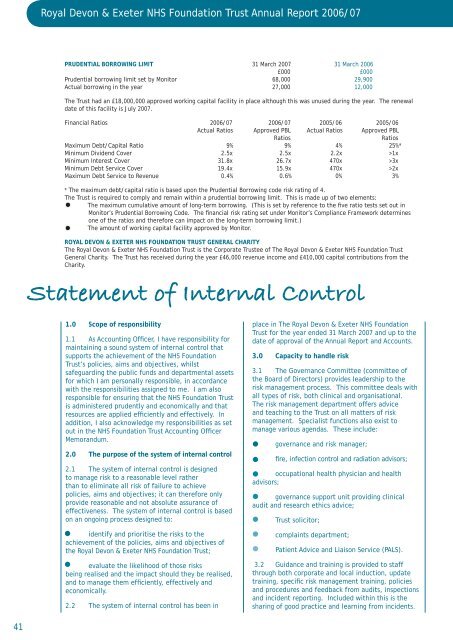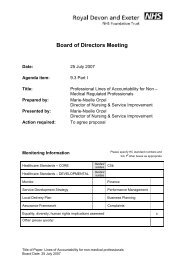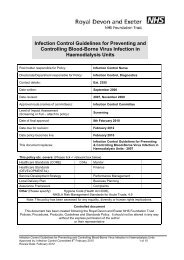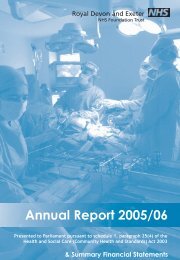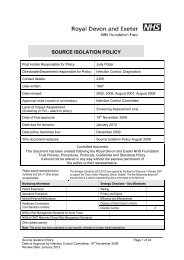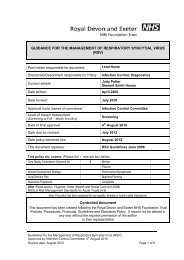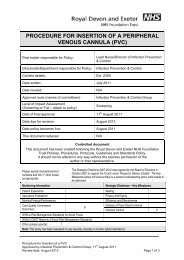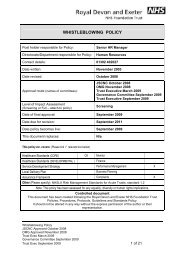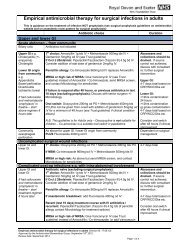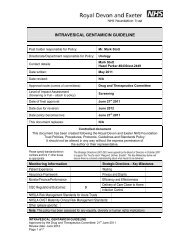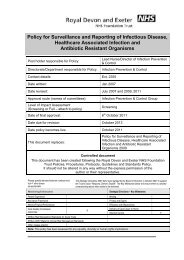Annual Report 2006/07 - Royal Devon & Exeter Hospital
Annual Report 2006/07 - Royal Devon & Exeter Hospital
Annual Report 2006/07 - Royal Devon & Exeter Hospital
You also want an ePaper? Increase the reach of your titles
YUMPU automatically turns print PDFs into web optimized ePapers that Google loves.
<strong>Royal</strong> <strong>Devon</strong> & <strong>Exeter</strong> NHS Foundation Trust <strong>Annual</strong> <strong>Report</strong> <strong>2006</strong>/<strong>07</strong><br />
PRUDENTIAL BORROWING LIMIT 31 March 20<strong>07</strong> 31 March <strong>2006</strong><br />
£000 £000<br />
Prudential borrowing limit set by Monitor 68,000 29,900<br />
Actual borrowing in the year 27,000 12,000<br />
The Trust had an £18,000,000 approved working capital facility in place although this was unused during the year. The renewal<br />
date of this facility is July 20<strong>07</strong>.<br />
Financial Ratios <strong>2006</strong>/<strong>07</strong> <strong>2006</strong>/<strong>07</strong> 2005/06 2005/06<br />
Actual Ratios Approved PBL Actual Ratios Approved PBL<br />
Ratios<br />
Ratios<br />
Maximum Debt/Capital Ratio 9% 9% 4% 25%*<br />
Minimum Dividend Cover 2.5x 2.5x 2.2x >1x<br />
Minimum Interest Cover 31.8x 26.7x 470x >3x<br />
Minimum Debt Service Cover 19.4x 15.9x 470x >2x<br />
Maximum Debt Service to Revenue 0.4% 0.6% 0% 3%<br />
* The maximum debt/capital ratio is based upon the Prudential Borrowing code risk rating of 4.<br />
The Trust is required to comply and remain within a prudential borrowing limit. This is made up of two elements:<br />
The maximum cumulative amount of long-term borrowing. (This is set by reference to the five ratio tests set out in<br />
Monitor’s Prudential Borrowing Code. The financial risk rating set under Monitor’s Compliance Framework determines<br />
one of the ratios and therefore can impact on the long-term borrowing limit.)<br />
The amount of working capital facility approved by Monitor.<br />
ROYAL DEVON & EXETER NHS FOUNDATION TRUST GENERAL CHARITY<br />
The <strong>Royal</strong> <strong>Devon</strong> & <strong>Exeter</strong> NHS Foundation Trust is the Corporate Trustee of The <strong>Royal</strong> <strong>Devon</strong> & <strong>Exeter</strong> NHS Foundation Trust<br />
General Charity. The Trust has received during the year £46,000 revenue income and £410,000 capital contributions from the<br />
Charity.<br />
Statement of Internal Control<br />
1.0 Scope of responsibility<br />
1.1 As Accounting Officer, I have responsibility for<br />
maintaining a sound system of internal control that<br />
supports the achievement of the NHS Foundation<br />
Trust’s policies, aims and objectives, whilst<br />
safeguarding the public funds and departmental assets<br />
for which I am personally responsible, in accordance<br />
with the responsibilities assigned to me. I am also<br />
responsible for ensuring that the NHS Foundation Trust<br />
is administered prudently and economically and that<br />
resources are applied efficiently and effectively. In<br />
addition, I also acknowledge my responsibilities as set<br />
out in the NHS Foundation Trust Accounting Officer<br />
Memorandum.<br />
2.0 The purpose of the system of internal control<br />
2.1 The system of internal control is designed<br />
to manage risk to a reasonable level rather<br />
than to eliminate all risk of failure to achieve<br />
policies, aims and objectives; it can therefore only<br />
provide reasonable and not absolute assurance of<br />
effectiveness. The system of internal control is based<br />
on an ongoing process designed to:<br />
identify and prioritise the risks to the<br />
achievement of the policies, aims and objectives of<br />
the <strong>Royal</strong> <strong>Devon</strong> & <strong>Exeter</strong> NHS Foundation Trust;<br />
evaluate the likelihood of those risks<br />
being realised and the impact should they be realised,<br />
and to manage them efficiently, effectively and<br />
economically.<br />
2.2 The system of internal control has been in<br />
place in The <strong>Royal</strong> <strong>Devon</strong> & <strong>Exeter</strong> NHS Foundation<br />
Trust for the year ended 31 March 20<strong>07</strong> and up to the<br />
date of approval of the <strong>Annual</strong> <strong>Report</strong> and Accounts.<br />
3.0 Capacity to handle risk<br />
3.1 The Governance Committee (committee of<br />
the Board of Directors) provides leadership to the<br />
risk management process. This committee deals with<br />
all types of risk, both clinical and organisational.<br />
The risk management department offers advice<br />
and teaching to the Trust on all matters of risk<br />
management. Specialist functions also exist to<br />
manage various agendas. These include:<br />
governance and risk manager;<br />
fire, infection control and radiation advisors;<br />
occupational health physician and health<br />
advisors;<br />
governance support unit providing clinical<br />
audit and research ethics advice;<br />
Trust solicitor;<br />
complaints department;<br />
Patient Advice and Liaison Service (PALS).<br />
3.2 Guidance and training is provided to staff<br />
through both corporate and local induction, update<br />
training, specific risk management training, policies<br />
and procedures and feedback from audits, inspections<br />
and incident reporting. Included within this is the<br />
sharing of good practice and learning from incidents.<br />
41


